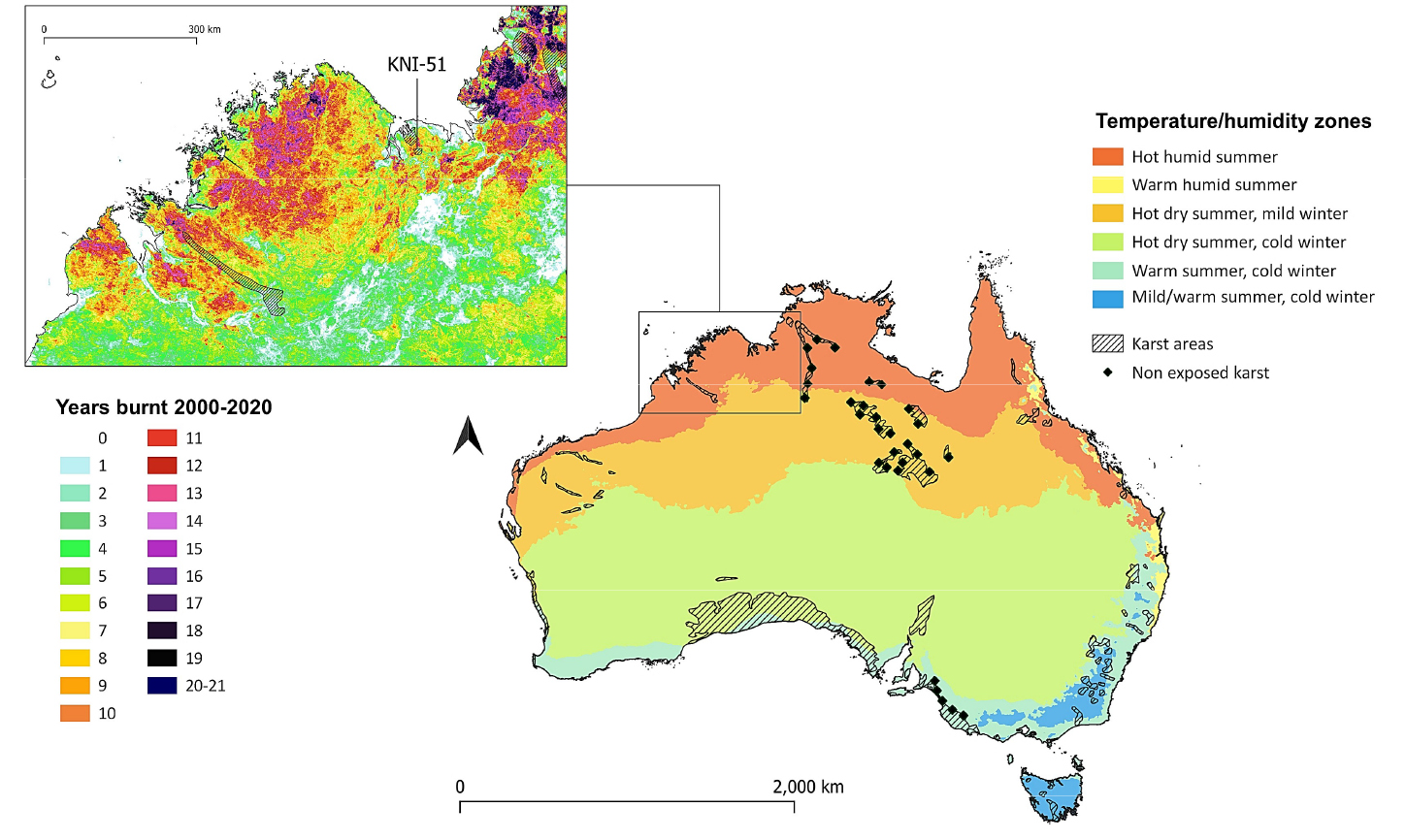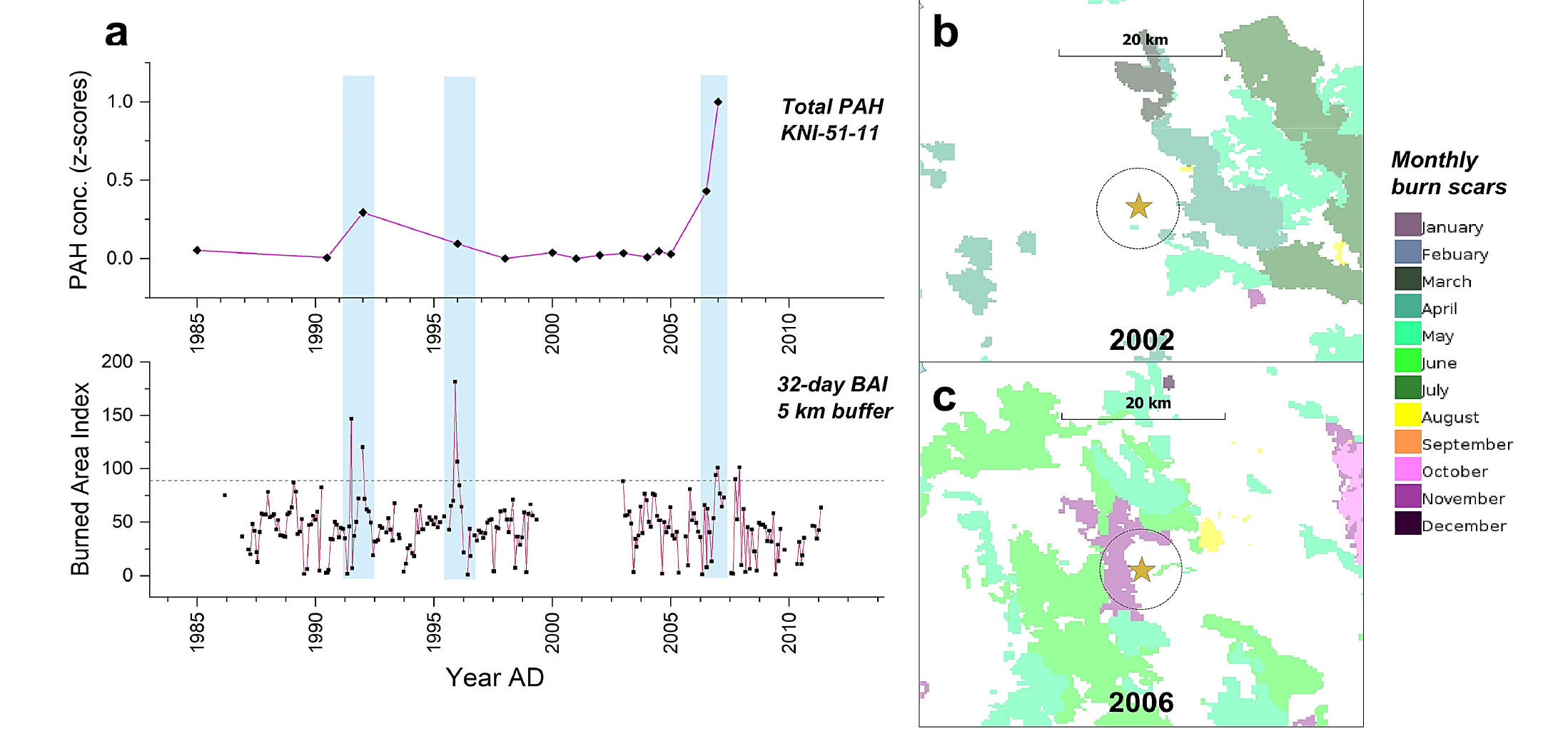- Home
- Publications
- PAGES Magazine
- Speleothems As a Novel Tool To Elucidate Human–fire–ecosystem Dynamics In Tropical Australian Savanna
Speleothems as a novel tool to elucidate human–fire–ecosystem dynamics in tropical Australian savanna
Elena Argiriadis, R.F. Denniston, S. Ondei and D.M.J.S Bowman
Past Global Changes Magazine
31(1)
14-15
2023
Fire–climate–human relationships in Australian tropical savannas are poorly understood in pre-industrial periods, particularly at centennial to millennial time-scales. Stalagmites from a cave in the Kimberley region hold the potential for high-resolution paleofire reconstruction from pyrogenic organic compounds spanning these timescales.
A need for novel, high-resolution paleofire records in Australian tropical savannas
The history of human management of fire in Australia dates to at least 50 kyr BP (Wurster et al. 2021). However, existing paleofire reconstructions are sparse, both temporally and spatially heterogeneous, and often poorly resolved. This limits our ability to assess the relative impacts of climate and Aboriginal land and fire management on ecological change. Nonetheless, long-term human influences on vegetation and fire frequency are widely demonstrated (Vigilante et al. 2009). At the end of the 18th century, European settlers in southeastern Australia modified interactions between natural drivers of fire and Indigenous management. This led to changes in patterns of fire regimes, which likely contributed to the decline of land mammals and fire-sensitive plants observed throughout the country (e.g. Bowman et al. 2022; Woinarski et al. 2015).
In the fire-prone tropical savannas of northwestern Australia, the lack of long-term, high-resolution paleofire reconstructions is particularly acute. This is due to a scarcity of permanent water bodies and other undisturbed depositional environments suitable for the preservation of biomarkers or paleoecological proxies, such as charcoal and pollen (Wurster et al. 2021). For this reason, exploring the potential of novel, highly resolved, and stable archives is of increasing interest.
Stalagmites from limestone caves are a widely used paleoclimate archive, given that they can grow continuously for thousands of years, resist alteration, enable the use of precise dating methods, and provide high-resolution paleoenvironmental information through different proxies. Stable isotopes of oxygen and carbon, along with trace elements (e.g. Mg, Sr, U), are the main geochemical proxies used in speleothems for paleoclimate reconstruction, most notably paleomonsoon reconstruction (Denniston et al. 2016). The study of organic compounds (e.g. lipids, phenols, and aromatic hydrocarbons) in speleothems is less well developed, despite their potential to preserve paleoenvironmental signals unattainable by inorganic compounds (Blyth et al. 2016).
Caves exist across many parts of Australia, including the tropical areas. An extended, exposed limestone area (Fig. 1) is present in the Kimberley region of northwestern Australia, where the richness in rock art sites documents early human settlement, with some of the oldest paintings dating back to 40 kyr BP. Here, aboriginal management based on localized small-scale burning is believed to have allowed fire regulation and the conservation of fire-sensitive flora and fauna, in contrast with European practices promoting further burning and ecological losses (Yibarbuk et al. 2001). Our research aims to extract records of paleofire activity from Kimberley stalagmites, at near annual resolution, to shed light on complex fire–climate–human relationships in the last millennium, when this abrupt shift in the fire-ecology equilibrium occurred.
Fire proxies in speleothems
Paleofire reconstruction from stalagmites is currently taking its first steps, and is rapidly accelerating, as demonstrated by recent studies where Holocene fire activity in different regions worldwide was investigated through inorganic and organic geochemical proxies. For instance, McDonough et al. (2022) associated peaks in P, Al, Zn, and Cu in a southwest Australian stalagmite to known fire events and prescribed burns, while Homann et al. (2022) related traces of the organic compound levoglucosan in a stalagmite from California to hydroclimate and fuel availability that promoted changes in early Holocene fire activity.
Previous work by Argiriadis et al. (2019) presented a method for the analysis of trace polycyclic aromatic hydrocarbons (PAHs) and n-alkanes in stalagmites. These organic compounds reflect biogeochemical processes occurring at the land surface, in the soil, and in the cave. PAHs are primarily related to combustion of biomass, while n-alkanes, with their potential for vegetation reconstruction, provide information on fuel availability and composition. These target organic molecules are carried into the underlying cave by infiltrating water, and finally incorporated into speleothems; thereby, creating the potential for speleothems to serve as novel paleofire archives.
PAHs are organic molecules composed of two or more fused aromatic rings and result from incomplete combustion of organic materials. According to fuel and combustion conditions, a wide range of PAHs are associated with biomass burning. Immediately after fires of moderate intensity (200–400°C), abundance of light and medium molecular weight (LMW and MMW, respectively) compounds are elevated in burnt soils, while high molecular weight PAHs (HMW) are rare to absent (Rey-Salgueiro et al. 2018). HMW PAHs are generally only produced at temperatures higher than ~500˚C and are, thus, associated with fossil fuel combustion or very intense fires of woody material (Wang et al. 2017). PAHs are highly persistent in the environment but have generally low concentrations in natural waters due to their low solubility, while soil PAHs are, for the most part, adsorbed onto organic matter-specific sites.
To date, the only known attempt to use PAHs for stalagmite fire reconstruction was performed by Perrette et al. (2008), although the study faced some difficulties due to the complex nature of thick soils and depth of the cave, and, thus, did not yield conclusive paleoenvironmental information. In contrast, cave KNI-51, located in the Kimberley region (tropical northwestern Australia) (Fig. 1), appears to be an ideal setting for the rapid transportation of organic compounds from the land surface to the underlying cave, given that it is a shallow location, covered by thin soil, and permeable and fractured limestone. Stalagmites at cave KNI-51 are also well-suited for this work, as they show high growth rates (1–2 mm yr-1) and yield extremely high precision 230Th dates (2 SD errors = ±1 year over most of the last century), which together offer high (1–3 yr) temporal resolution for PAH measurements.
 |
|
Figure 1: Australian climate zones (source: Australian Government Bureau of Meteorology, bom.gov.au) with karst areas distribution (source: World Karst Aquifer Map, whymap.org). Kimberley region with fire frequency and cave KNI-51 location (source: NAFI, North Australia & Rangelands Fire Information, firenorth.org.au). |
We analyzed PAHs in three aragonite stalagmites from cave KNI-51. The stalagmites grew during different intervals of the last millennium, and include one that spans most of the period between 1750–2009 CE (KNI-51–11). This time interval encompasses the arrival of European pastoralists in the Kimberley region in the late 19th century.
Comparison with satellite data
PAH concentrations in the interval between 1984 and 2007 were compared with the Burned Area Index (BAI), a satellite-derived spectral index obtained from near-infrared reflectance (Chuvieco et al. 2010), computed through Google Earth Engine (GEE) using Landsat 5 Collection 1 Tier 1 images. High normalized PAH concentrations in stalagmite KNI-51–11 coincide with values in the 32-day BAI composite within a 5 km radius around the cave ≥89, which corresponds to the threshold identified by Martin et al. (2005) as indicative of burned areas (Fig. 2). Although differences in resolution between the BAI and PAH records must be considered (BAI composite is given here with a 32-day frequency, while average PAH resolution, although remarkable for a stalagmite record, is 1.6 yr), together with dating uncertainties, the stalagmite PAH record shows potential to capture the signal from bushfires occurring close to the cave, especially in the late dry season (September–November), as shown in high resolution fire–scar maps (Fig. 2). Although preliminary, this finding is a first indication of the validity of our method for long-term fire reconstruction.
 |
|
Figure 2: (A) Total PAH concentrations (z-scores) from stalagmite KNI-51-11 (top), and 32-days composite of the Burned Area Index within a 5 km radius around the cave (bottom). (B) Monthly fire scars (areas of blackened land surface following vegetation fires identified through MODIS 250m satellite imagery) in the cave area in year 2002, and (C) in 2006 (source: NAFI, North Australia & Rangelands Fire Information, firenorth.org.au). |
Future work
As the use of speleothems as a paleofire proxy is in its infancy, several important tests are underway. First, we continued to analyze coeval stalagmites from the same cave to assess the degree of replication in PAH values and trends. Second, during cave floods events, stalagmite caps are coated with sediment, some of which is incorporated into the stalagmite when flood waters recede and stalagmite growth resumes, thus possibly acting as an additional source of organic compounds to the cave. Defining contributions of flood sediment to measured PAH abundances and distributions is critical to define the paleofire signal. Third, the transport of PAHs from the land surface to the cave is not well understood, so a prescribed burn and irrigation experiment will soon be performed to address this and related questions. Finally, contributions of organic compounds from regional oil fields, while extremely unlikely, will be examined as a potential source of contamination through analysis of benzene polycarboxylic acids (BPCA).
affiliations
1CNR-ISP, Institute of Polar Sciences, National Research Council of Italy, Venice, Italy
2Department of Environmental Sciences, Informatics and Statistics, University of Venice, Italy
3Department of Geology, Cornell College, Mount Vernon, USA
4School of Natural Sciences, University of Tasmania, Sandy Bay, Australia
contact
Elena Argiriadis: elena.argiriadis cnr.it (elena[dot]argiriadis[at]cnr[dot]it)
cnr.it (elena[dot]argiriadis[at]cnr[dot]it)
references
Argiriadis E et al. (2019) Anal Chem 91: 7007-7011
Bowman DMJS et al. (2022) Sci Rep 12: 9081
Chuvieco E et al. (2010) Int J Remote Sens 23: 5103-5110
Denniston RF et al. (2016) Sci Rep 6: 34485
Homann J et al. (2022) Nat Commun 13: 7175
McDonough LK et al. (2022) Geochim Cosmochim Acta 325: 258-277
Perrette Y et al. (2008) Chem Geol 251: 67-76
Rey-Salgueiro L et al. (2018) L Degrad Dev 29: 2112-2123
Vigilante T et al. (2009) In: Cochrane MA (Ed) Tropical Fire Ecology. Springer, 143-167
Wang C et al. (2017) Org Geochem 114: 1-11
Woinarski JCZ et al. (2015) Proc Natl Acad Sci 112: 4531-4540